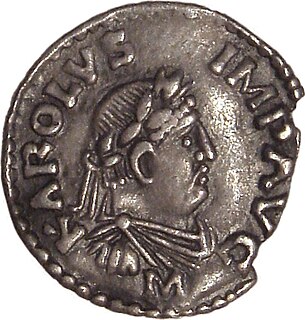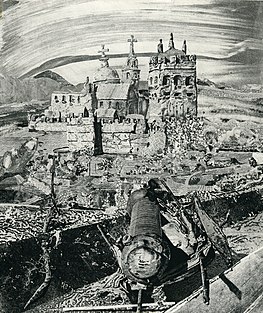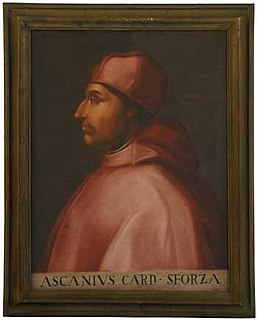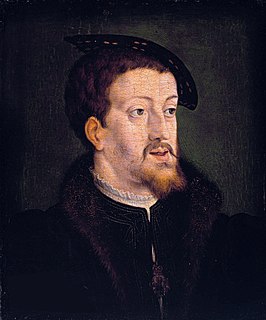Related Research Articles

Francesco I Sforza was an Italian condottiero who founded the Sforza dynasty in the duchy of Milan, ruling as its (fourth) duke from 1450 until his death. He was the brother of Alessandro, whom he often fought alongside.

The House of Sforza was a ruling family of Renaissance Italy, based in Milan. They acquired the Duchy of Milan following the extinction of the Visconti family in the mid-15th century, Sforza rule ending in Milan with the death of the last member of the family's main branch in 1535.
Year 1494 (MCDXCIV) was a common year starting on Wednesday of the Julian calendar.

The Holy Roman Emperor, originally and officially the Emperor of the Romans during the middle ages, and also known as the German-Roman Emperor since the early modern period, was the ruler and head of state of the Holy Roman Empire. The Empire was considered by the Roman Catholic Church to be the only legal successor of the Roman Empire during the Middle Ages and the early modern period. The title was held in conjunction with the title of King of Italy from the 8th to the 16th century, and, almost without interruption, with the title of King of Germany throughout the 12th to 18th centuries.

Charles VIII, called the Affable, was King of France from 1483 to his death in 1498. He succeeded his father Louis XI at the age of 13. His elder sister Anne acted as regent jointly with her husband Peter II, Duke of Bourbon until 1491 when the young king turned 21 years of age. During Anne's regency, the great lords rebelled against royal centralisation efforts in a conflict known as the Mad War (1485–1488), which resulted in a victory for the royal government.

Ferdinand I, also called Ferrante, was King of Naples from 1458 to 1494. He was an illegitimate son of Alfonso V of Aragon.

The Italian Wars, often referred to as the Great Wars of Italy and sometimes as the Habsburg–Valois Wars, were a long series of wars fought between 1494 and 1559 in Italy during the Renaissance. The Italian peninsula, economically advanced but politically divided among several states, became the main battleground for European supremacy. The conflicts involved the major powers of Italy and Europe, in a series of events that followed the end of the 40-year long Peace of Lodi agreed in 1454 with the formation of the Italic League.

The Kingdom of Naples comprised the part of the Italian Peninsula south of the Papal States between 1282 and 1816. It was established by the War of the Sicilian Vespers (1282–1302), when the island of Sicily revolted and was conquered by the Crown of Aragon, becoming a separate kingdom also called the Kingdom of Sicily. In 1816, it reunified with the island of Sicily to form the Kingdom of the Two Sicilies.

The War of the League of Cambrai, sometimes known as the War of the Holy League and several other names, was a major conflict in the Italian Wars of 1494–1559. The main participants of the war, fought from 1508 to 1516, were France, the Papal States, and the Republic of Venice, joined at various times by nearly every significant power in Western Europe, including Spain, the Holy Roman Empire, England, the Duchy of Milan, the Republic of Florence, the Duchy of Ferrara, and Swiss mercenaries.

Alfonso d'Este was Duke of Ferrara during the time of the War of the League of Cambrai.

The First Italian War, sometimes referred to as the Italian War of 1494 or Charles VIII's Italian War, was the opening phase of the Italian Wars. The war pitted Charles VIII of France, who had initial Milanese aid, against the Holy Roman Empire, Spain, and an alliance of Italian powers led by Pope Alexander VI.

The Second Italian War (1499–1501), sometimes known as Louis XII's Italian War and the Third Italian War (1502-1504) or the War over Naples, were the second and third of the Italian Wars; it was fought primarily by Louis XII of France and Ferdinand II of Aragon, with the participation of several Italian powers. In the aftermath of the First Italian War, Louis was determined to press his claim on the thrones of Milan and Naples. And in 1499, Louis XII invaded Lombardy and seized Milan, to which he had a claim in right of his paternal grandmother Valentina Visconti, Duchess of Orléans.

Ascanio Maria Sforza Visconti was an Italian Cardinal of the Catholic Church. Generally known as a skilled diplomat who played a major role in the election of Rodrigo Borgia as Pope Alexander VI, Sforza served as Vice-Chancellor of the Holy Roman Church from 1492 until 1505.

The imperial election of 1519 was an imperial election held to select the emperor of the Holy Roman Empire. It took place in Frankfurt on the 28th of June.
The imperial election of 1531 was an imperial election held to select the emperor of the Holy Roman Empire. It took place in Cologne on January 5.
The imperial election of 1562 was an imperial election held to select the emperor of the Holy Roman Empire. It took place in Regensburg on November 28.
The imperial election of 1658 was an imperial election held to select the emperor of the Holy Roman Empire. It took place in Frankfurt on July 18.

The Imperial election of 1257 was two imperial elections in the Holy Roman Empire held to select the emperor.